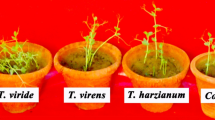Abstract
Sixteen isolates belonging to 11 species of Trichoderma (T. asperellum, T. ceramicum, T. andinensis, T. orientalis, T. atroviride, T. viridescens, T. brevicompactum, T. harzianum, T. virens, T. koningii and T. koningiopsis) were evaluated for biological control of potato (Solanum tuberosum) stem rot caused by Sclerotinia sclerotiorum. In dual culture tests, all antagonists significantly reduced sclerotia formation, and were able to inhibit radial growth of the pathogen. Growth inhibition by production of volatile and non-volatile inhibitors was also measured in in vitro tests. In screening the most efficient species of Trichoderma, establishment of mycelium on sclerotia and sclerotia lysis were also considered as important biocontrol qualities. Excluding T. asperellum, T. brevicompactum, T. andinensis and T. harzianum, all tested Trichoderma species were able to lyse sclerotia. The sclerotia-destroying species of Trichoderma and one isolate of Talaromyces flavus were tested in greenhouse tests and during 2 years of field experimentation during the 2007 and 2008 cropping seasons. After one aerial application of spore suspension in greenhouse trials, T. koningii, T. virens, T. ceramicum and T. viridescens were the most effective bio-agents and reduced significantly disease severity, and the least biocontrol efficacy was observed in T. flavus. Under field conditions and after five soil and foliar applications of spore suspension, all tested antagonists reduced significantly disease incidence. T. viridescens followed by T. ceramicum showed the best results. T. flavus and T. orientalis were less effective than other tested antagonists in both field trials.


Similar content being viewed by others
References
Atallah, Z. K., & Johnson, D. A. (2004). Development of Sclerotinia stem rot in potato fields in south-central Washington. Plant Disease, 88, 419–423.
Clarkson, J. P., & Whipps, J. M. (2002). Control of sclerotial pathogens in horticulture. Pesticide Outlook, June, 97–101.
Dennis, C., & Webster, J. (1971a). Antagonistic properties of species groups of Trichoderma I. Production of non-volatile antibiotics. Transactions of the British Mycological Society, 57, 25–39.
Dennis, C., & Webster, J. (1971b). Antagonistic properties of species-groups of Trichoderma II. Production of volatile antibiotics. Transactions of the British Mycological Society, 57, 41–43.
Dubey, S. C., Suresh, M., & Sing, B. (2007). Evaluation of Trichoderma species against Fusarium oxysporum f. sp. ciceris for integrated management of chickpea wilt. Biological Control, 40, 118–127.
Dueck, J., Morrall, R. A. A., & McKenzie, D. L. (1993). Control of Sclerotinia sclerotiorum in rapeseed with fungicides. Canadian Journal of Plant Pathology, 5, 289–293.
Elad, Y., Chet, I., & Katan, J. (1980). Trichoderma harzianum: a biocontrol agent effective against Sclerotium rolfsii and Rhizoctonia solani. Phytopathology, 70, 119–121.
Gerlagh, M., Goossen-van de Geijn, H. M., Fokkema, N. J., & Vereijken, P. F. G. (1999). Long-term biosanitation by application of Coniothyrium minitans on Sclerotinia sclerotiorum-infected crops. Phytopathology, 89, 141–147.
Gomez, K. A., & Gomez, A. A. (1984). Statistical procedures for agricultural research (pp. 139–153). Singapore: John Wiley and Sons.
Huang, H. C., Bremer, E., Hynes, R. K., & Erickson, R. S. (2000). Foliar application of fungal biocontrol agents for the control of white mold of dry bean caused by Sclerotinia sclerotiorum. Biological Control, 18, 270–276.
Inbar, J., Menendez, A., & Chet, I. (1996). Hyphal interaction between Trichoderma harzianum and Sclerotinia sclerotiorum and its role in biological control. Soil Biology and Biochemistry, 28, 757–763.
Kumar, D., & Dubey, S. C. (2001). Management of collar rot of pea by the integration of biological and chemical methods. Indian Phytopathology, 57, 62–66.
Li, G. Q., Huang, H. C., Acharya, S. N., & Erickson, R. S. (2005). Effectiveness of Coniothyrium minitans and Trichoderma atroviride in suppression of sclerotinia blossom blight of alfalfa. Plant Pathology, 54, 204–211.
McLaren, D. L., Kozub, G. C., & Rimmer, S. R. (1994). Biological control of sclerotinia wilt of sunflower with Talaromyces flavus and Coniothyrium minitans. Plant Disease, 78, 231–235.
Morton, D. T., & Stroube, N. H. (1955). Antagonistic and stimulatory effects of microorganisms upon Sclerotium rolfsii. Phytopathology, 45, 419–420.
Ojaghian, M. R. (2009). First report of Sclerotinia sclerotiorum on potato plants in Iran. Australasian Plant Disease Notes, 4, 39–41.
Padmodaya, B., & Reddy, H. R. (1996). Screening of Trichoderma spp. against Fusarium oxysporum f. sp. lycopersici causing wilt in tomato. Indian Journal of Mycology and Plant Pathology, 26, 266–270.
Partyka, R. E., & Mai, W. F. (1961). Effects of environment and some chemicals on Sclerotinia sclerotiorum in laboratory and potato field. Phytopathology, 52, 766–770.
Poddar, R. K., Singh, D. V., & Dubey, S. C. (2004). Integrated application of Trichoderma harzianum mutants and carbendazim to manage chickpea wilt (Fusarium oxysporum f. sp. ciceri). The Indian Journal of Agricultural Sciences, 74, 346–348.
Purdy, L. H. (1979). Sclerotinia sclerotiorum: history, diseases and symptomatology, host range, geographic distribution and impact. Phytopathology, 69, 875–880.
Whipps, J. M., & Budge, S. P. (1990). Screening for sclerotial mycoparasites of Sclerotinia sclerotiorum. Mycological Research, 94, 607–612.
Acknowledgments
The author would like to extend sincere gratitude to Dr. Doostmorad Zafari, Dr. Gholam Khodakaramian and Dr. Mohammad Javad Soleimani for their technical support and for their advice to improve this article.
Author information
Authors and Affiliations
Corresponding author
Rights and permissions
About this article
Cite this article
Ojaghian, M.R. Potential of Trichoderma spp. and Talaromyces flavus for biological control of potato stem rot caused by Sclerotinia sclerotiorum . Phytoparasitica 39, 185–193 (2011). https://doi.org/10.1007/s12600-011-0153-9
Received:
Accepted:
Published:
Issue Date:
DOI: https://doi.org/10.1007/s12600-011-0153-9




